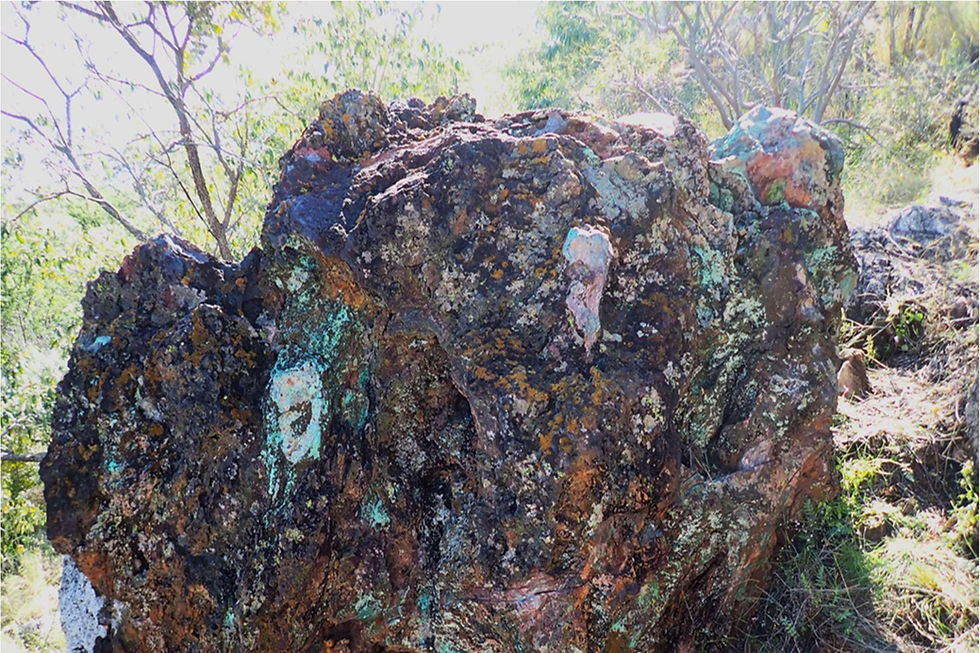Golden Deeps nails bonanza copper-silver-germanium grades in Namibia
- James Pearson

- Aug 21
- 4 min read

Golden Deeps Limited’s (ASX: GED) share price is on the hoof today, up as much as 43 per cent to 5 cents a share on its best turnover in five months, after the company unleashed a fresh batch of eye-watering rock chip results from its Central Otavi polymetallic project in northern Namibia.
The latest results from 55 samples delivered grades that would make most miners rub their eyes twice. The stunning rock chip samples recorded up to 50.6 per cent copper, a massive 7.792 kilograms per tonne (kg/t) of silver and a monster 224 grams per tonne (g/t) germanium.
The current exploration program followed an initial round of sampling at the start of August, which identified two parallel and distinct corridors, dubbed Gossan 1 and Gossan 2, lying within a 1-kilometre by 800-metre zone that pulled up 74 rock chips with other startling results.
Soil and rock chip sampling has now stretched the Gossan 1 corridor twice its original length, blowing out the mineralised footprint to a hefty 2km by 1km zone packed with anomalous hits.
Armed with a better understanding of the area’s geological structures, Golden Deeps focused its expanded sampling program on a particular spot called the Graceland prospect.
The hotspot sits within the two gossan corridors, where three mineralised copper, zinc and lead trends - picked up in previous geochemical analysis - appear to coincide.
At one surface gossan, G1 East, the same rock chip hit almost 8kg/t of silver, 47.3 per cent copper and a massive 547g/t stibnite - the source rock for antimony. Another sample from the same gossan picked up 13.8 per cent copper and 171g/t silver to go with the spectacular 224g/t germanium hit.
Adding to the fireworks, at the G1 West gossan an additional rock chip was reported going at 50.6 per cent copper, while at the G2 North target, four samples clicked through at copper grades between 22 per cent and 31 per cent, with associated germanium averaging 26.6g/t and silver running at up to 3.179kg/t.
Across the G1 and G2 corridors, grades of zinc and lead were equally impressive, with some zones topping 30 per cent zinc and nearly 28 per cent lead.
Management says that with these kinds of numbers, it’s hard to ignore the striking similarities between its Otavi project and the fabled Tsumeb deposit 20km away. Tsumeb historically produced 27 million tonnes grading 4.3 per cent copper, 10 per cent lead, 3.5 per cent zinc, 95g/t silver and 50g/t germanium.
These extraordinary new silver, copper and germanium results clearly demonstrate the potential of the Graceland prospect to host rich deposits of several critical, high-demand and valuable metals.
Golden Deeps Limited CEO Jon Dugdale
Golden Deeps has now completed trenching and channel sampling across the newly identified gossans and has 254 samples in the lab. It expects to receive these results within weeks, which will help the company map out thickness and continuity of the high-grade zones.
On top of that, it is about to kick off an all-important induced polarisation (IP) geophysical survey to test drill-ready sulphide treasures that may be lurking beneath the surface.
Golden Deeps is also in discussions with local contractors to secure access to rigs capable of operating in the hilly Otavi terrain. Drilling is set to begin when it has its survey and channel results in hand. The first holes will likely probe the surface gossans and deeper geophysical conductors.
Golden Deeps has already had exploration success at some of its other prospects, which sit within 440 square kilometres in Namibia’s Otavi Mountain Land. At the Nosib discovery, 20km north of Graceland, the company recently announced high-grade gallium with copper, vanadium, lead and silver, together with strong sniffs of germanium and antimony from surface.
The picture starting to emerge is one of multiple, highly prospective and structurally controlled targets ripe for polymetallic discoveries - especially critical metals such as germanium. The greyish-white element is a key ingredient in the manufacture of semiconductors and photovoltaic cells.
China largely controls the global germanium and gallium supplies, but announced export bans six months ago. The price of each commodity has since soared, with germanium now fetching more than US$3 million (A$4.61 million) per tonne.
It’s little wonder Golden Deeps is itching to test the economic muscle of its germanium find, which if viable, could end up matching, or even outshining, the dollar value of the company’s entire copper and silver haul.
With drill rigs waiting in the wings and assays already breaking records, the stage is set for the junior explorer to test whether these rock chip bonanzas at the Graceland prospect extend deeper into mineable sulphide bodies.
If the grades hold up at depth, the company may well be on the cusp of one of Namibia’s most exciting polymetallic discoveries in decades.
Is your ASX-listed company doing something interesting? Contact: office@bullsnbears.com.au


